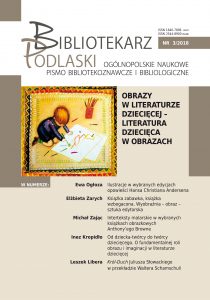Abstract
The aim of this article is presentation of multitude and variety imaging ways used by Adolf Dygasinski in "Cudowne bajki" – the composition of nine incredible stories for young reader. The authoress’ reflections
concern fabulous love, fantastic componenets, portraits of animals and childish fear. She persuades it’s important to save "Cudowne bajki" from oblivion because of their educational and pedagogical advantages. Futhermore she suggests inclusion of this composition to Polish education but she also pays attention to necessity of some changes in lexical and graphical aspect. In addition to that she presents fabulous stories in context of chosen contemporary conceptions of interpretation, for example hermeneutics, intertextuality, posthumanism or ethic turn.
References
Bettelheim B., Cudowne i pożyteczne. O znaczeniach i wartościach baśni, t. 1 i 2, tłum. D. Danek, Warszawa 1985.
Bettelheim B., Cudowne i pożyteczne: znaczenie i doniosłość baśni, tłum. D. Danek, „Teksty” 1980, nr 1.
Chrobak M., O potrzebie brzydoty w baśniach, [w:] Dziecko i baśnie świata w kontekście wczesnej edukacji, red. U. Chęcińska, Szczecin 2016.
Dybel P., Pytanie o człowieka w hermeneutyce Gadamera, „Analiza i Egzystencja” 2012, nr 19.
Dygasiński A., Cudowne bajki, Warszawa 1939.
Dygasiński A., Listy, oprac. T. Nuckowski, Wrocław 1972.
Dygasiński A., Pisma pedagogiczne, wstęp i oprac. W. Danek, Wrocław 1957.
Gierczak S., Dawno, dawno temu… Rozważania o baśni w kontekstach aksjologicznych, „Język Polski w Szkole Podstawowej” 2017/2018, nr 3.
Gierczak S., „Ludzie oto bajali i bajali… tak sobie; kto by ta wierzył?” O ludowej mentalności w „Cudownych bajkach” Adolfa Dygasińskiego, [w:] Filozoficzne aspekty literatury. Strategie interpretacyjne, red. A. Skała, Lublin 2018.
Hoły-Łuczaj M., Posthumanizm. Między metafizyką a etyką, „Kultura i Wartości” 2015, nr 1.
Jaskółowa E., Uwolnić interpretację, [w:] Nowe odsłony klasyki w szkole, red. E. Jaskółowa i K. Jędrych, Katowice 2013.
Kalinowski K., Kościsko, Warszawa 2016.
Kostecka W., Baśń postmodernistyczna: przeobrażenia gatunku. Intertekstualne gry z tradycją literacką, Warszawa 2014.
Koziołek K., Czytanie z Innym. Etyka. Lektura. Dydaktyka, Katowice 2006.
Kristeva J., Problemy strukturowania tekstu, „Pamiętnik Literacki” 1972, z. 4.
Leszczyński G., Wielkie małe książki. Lektury dzieci. I nie tylko, Poznań 2015.
Markowski M. P., Zwrot etyczny w badaniach literackich, „Pamiętnik Literacki” 2000, z. 1
Morawska I., INNY jako wyzwanie komunikacyjne i edukacyjne, [w:] KOMUNIKACJA. Tradycja i innowacje, red. M. Karwatowska, A. Siwiec, Chełm 2013.
Myrdzik B., Zrozumieć siebie i świat. Szkice i studia o edukacji polonistycznej, Lublin 2006.
Nussbaum M., Czytać, aby żyć, tłum. A. Bielik-Robson, „Teksty Drugie” 2002, nr 1/2.
Papuzińska J., Zatopione królestwo. O polskiej literaturze fantastycznej XX wieku dla dzieci i młodzieży, Łódź 2008.
Propp W., Morfologia bajki, tłum. W. Wojtyga-Zagórska, Warszawa 1976.
Skała A., O psiej perspektywie, oślej autobiografii i etosie kukułki. Uwagi o pisarstwie Adolfa Dygasińskiego, „Wiek XIX. Rocznik Towarzystwa Literackiego im. Adama Mickiewicza” 2014, nr XLIX.
Slany K., Groza w literaturze dziecięcej: od Grimmów do Gaimana, Kraków 2016.
Słownik literatury dziecięcej i młodzieżowej, red. B. Tylicka i G. Leszczyński, Wrocław 2002.
Waksmund R., Od literatury dla dzieci do literatury dziecięcej (tematy – gatunki –konteksty), Wrocław 2000.
Zych P., Vargas W., Bestiariusz słowiański, t. 1, Olszanica 2012.
Articles published in the “gold open access” mode on the basis of a non-exclusive license agreement between the publisher and the author. Permitted use:
- the publication may be read and stored on any device,
- the publication may be cited (with obligatory reference to the author, the title of the text, as well as the full title, bibliographic address of the issue and page of the journal)
The editorial team of “Bibliotekarz Podlaski” implements an open access policy by publishing materials in the form of the so-called Gold Open Access. From volume 42 (issue 1/2019), the journal is available under the Creative Commons license (Attribution – ShareAlike: CC BY-SA).
The key declarations of the Open Access and Open Science movement, which we fully support, are available on the CEON Open Science website.
COPYRIGHT:
The editorial team of “Bibliotekarz Podlaski” implements an open access policy by publishing materials in the form of the so-called Gold Open Access. The journal is available under the Creative Commons license – Attribution – ShareAlike 4.0: International: CC BY-SA 4.0).
The key declarations of the Open Access and Open Science movement, which we fully support, are available on the CEON Open Science website.
“Bibliotekarz Podlaski” allows its readers to read, download, copy, distribute, print, search and link to the full content of articles. We enable full, immediate, unlimited (both in a territorial, temporal and technical sense) open access to all published content, in accordance with the principle that freely available research increases and accelerates the global development of science and the exchange of knowledge.
The editorial team of “Bibliotekarz Podlaski” encourages authors to place articles published in the journal in open repositories (after the review or the final version of the publisher), provided that a link to the journal’s website is provided.
The journal does not charge the authors any fees for accepting and publishing their texts.

